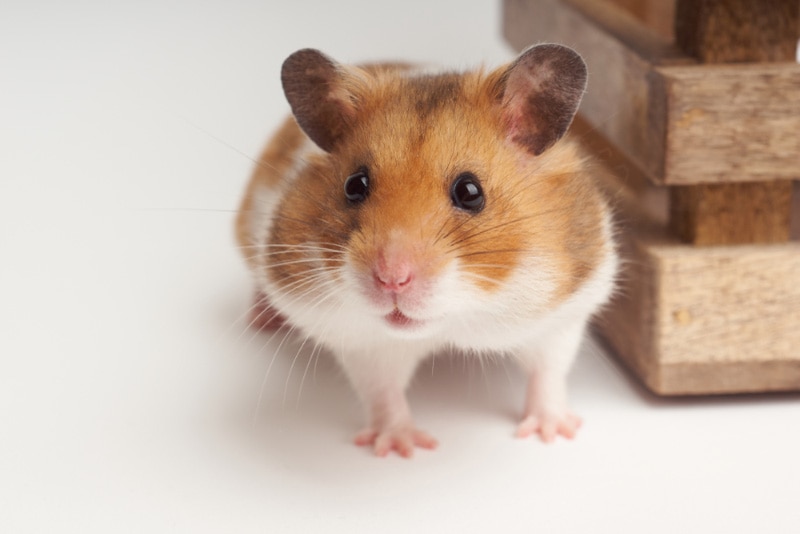
The information is current and up-to-date in accordance with the latest veterinarian research.
Learn more »
It’s a known fact that many animals have excellent sight, particularly when compared to our own. But as a hamster owner, have you ever wondered how well your hammy can see?
A hamster’s vision is poor but well adapted to what they need to navigate the world. They have limited color vision, and they see things best when they’re close up—only a few inches in front of their faces; anything beyond this is fuzzy. However, their eyes are adapted for low light conditions, and they have other senses that make up for their limited eyesight.
In this article, we discuss why hamsters have such bad eyesight, along with other hamster vision facts.
The Hamster’s Eyesight
Image Credit: Ken Saldua, Shutterstock
A 2009 study conducted by researchers at Kyungpook National University in Korea described the number and type of photoreceptors, or light-sensitive cells, in a hamster’s retina.1
Eyes are made up of rods and cones, which work like this:
Cones: Cones allow color vision and work in daylight conditions. Hamster’s eyes have 3.01% cones.
Rods: Rods allow vision in low light conditions and require minimal amounts of light to function. Hamster’s eyes have 96.99% rods.
Since hamster eyes have far more rods than cones, this tells us that they see best in low light, and hamsters can behave as nocturnal and crepuscular.
20/2,000 Vision
A 2011 study reported that mice have the equivalent of 20/2,000 vision, and hamsters have similar eyesight to mice.2 In humans, 20/200 is considered legally blind: The numbers mean you need to be 20 feet away to see something that someone with “normal” vision can see from about 200 feet away.
But what this all tells us is that hamsters have terrible vision! They literally can only see what is directly in front of their noses.
Why Do Hamsters Have Bad Eyesight?
Image Credit: TakanashiRikka, Shutterstock
Hamsters have poor eyesight when compared to humans, who rely on vision as our primary sense to move through the world. However, hamsters have a highly acute sense of hearing and smell, and their sensitive whiskers help them find objects. Hamsters’ vision suits their crepuscular and nocturnal habits.
In the wild, hamsters dig burrows and sleep during the day, and they venture out at dawn and dusk to forage for food. Only emerging at these times helps reduce the number of predators that hunt animals like hamsters. The temperature is also more suitable for hamsters at sunset and sunrise.
Just because hamsters are kept as pets and live with us doesn’t mean their habits have changed. You’ll see your hamster become much more active when the rest of us are winding down for the day.
How Well Can Hamsters Hear?
Hamsters communicate with each other using frequencies that we are unable to hear. They have sensitive ears, so keeping the noise in the household down in the vicinity of your hamster’s cage is vital. Too much loud noise can be distressing.
They use smell to find food and detect pheromones. Their heightened sense of smell helps them navigate the world without their limited sense of sight being a problem.
How Well Can Hamsters Smell?
The hamster’s sense of smell is the first sense used to figure out a situation or environment. It helps them identify other hamsters, even whether the other hamster is male or female.
They use smell to find food and detect pheromones. Their heightened sense of smell is why it’s best to wash your hands with unscented soap (and use unscented hand lotion) before handling your hamster, as fragrances can be overwhelming and confusing for your pet.
Image Credit: gashgeron, Shutterstock
Are Hamsters Color Blind?
Since hamsters are primarily nocturnal, their eyes are perfectly adapted to function in low light conditions, having far more rods than cones in their eyes. Hamsters have limited color vision, and they are considered dichromats, which means that they are able to differentiate between shades of greens and blues. They can’t see anything in the red spectrum.
Since hamsters see better in low light, it’s almost like they have their own personal set of night-vision goggles.
Can Hamsters See Well in the Dark?
Seeing in low light and seeing in the dark are different things. Hamsters need a bit of light to see anything. They are not nocturnal, like owls, for example, and don’t see much of anything in complete darkness.
Are Lights Distressing for Hamsters?
Hamsters’ typical activity rhythms mean that they sleep during the day and are most active from dusk to dawn. Artificial light should not harm your hamster, but you should ensure that your hamster has places where they can hide during the day. Hamsters don’t need anything like nightlights, as they are very well adapted to seeing in conditions with minimal light.
Image Credit: Remus Rigo, Shutterstock
Can Hamsters Recognize Their Owners?
If hamsters can’t see more than a few inches directly in front of their noses, how can they recognize their owners? They do so through their other senses. Hamsters have excellent senses of smell and hearing, which enable them to recognize their owners’ voices and unique scents over time.
If your hamster is still relatively new, it will take a while before they are ready to be handled, but once they become accustomed to your presence, they will likely start coming out of their burrow when you enter the room and they get your scent. It’s the hamster’s version of recognition!
Can Hamsters Lose Their Eyesight?
Unfortunately, hamsters can lose their eyesight due to various health problems. Some might be born blind, while others may develop ocular problems at a later age. To be clear, all hamsters are born blind because their eyelids are shut, but they open their eyes when they are around 10 to 14 days old.
Illnesses, including injuries and certain diseases, can lead to blindness. Eye bulging can result from glaucoma. Eye infections can be caused by different agents, such as bacteria and viruses, and are one of the most common causes of eye problems in hamsters.
Signs that your hamster might be blind include:
Cloudy eyes
Discharge from the eyes
Rubbing their eyes
Holding the eyes shut
Bumping into things
Lethargy
Problem finding things directly in front of their nose
Seems klutzy
If you suspect that your hamster might be having trouble with their vision, see your veterinarian immediately. If you don’t have a vet yet, when searching for one, ensure that they are experienced in exotics.
Hamsters can see a few inches in front of their noses and use their whiskers to feel for obstacles. A hamster that seems clumsy is something that you should have checked out.
Image Credit: v-svirido, Shutterstock
Conclusion
It’s important to keep in mind the particularities of vision in hamsters when you interact with them. If you “sneak up” on a hamster, they are more likely to bite because they are startled and afraid. It also helps explain hamsters’ reputation for being biters.
Always approach and handle your hamster gently. Avoid sudden movements, and keep in mind their heightened senses of hearing and smell. Once your hammy becomes familiar with you, you should have a fabulous bond with your new pet!
Featured Image Credit: Johannes Menge, Shutterstock






